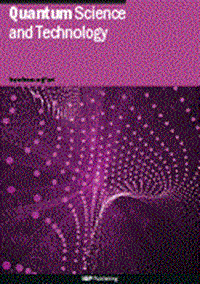Sample-based Hamiltonian and Lindbladian simulation: non-asymptotic analysis of sample complexity
IF 5
2区 物理与天体物理
Q1 PHYSICS, MULTIDISCIPLINARY
引用次数: 0
Abstract
Density matrix exponentiation (DME) is a quantum algorithm that processes multiple copies of a program state σ to realize the Hamiltonian evolution . Wave matrix Lindbladization (WML) similarly processes multiple copies of a program state ψL in order to realize a Lindbladian evolution. Both algorithms are prototypical sample-based quantum algorithms and can be used for various quantum information processing tasks, including quantum principal component analysis, Hamiltonian simulation, and Lindbladian simulation. In this work, we present detailed sample complexity analyses for DME and sample-based Hamiltonian simulation, as well as for WML and sample-based Lindbladian simulation. In particular, we prove that the sample complexity of DME is no larger than , where t is the desired evolution time and ɛ is the desired imprecision level, as quantified by the normalized diamond distance. We also establish a fundamental lower bound on the sample complexity of sample-based Hamiltonian simulation, which matches our DME sample complexity bound up to a constant multiplicative factor, thereby proving that DME is optimal for sample-based Hamiltonian simulation. Additionally, we prove that the sample complexity of WML is no larger than , where d is the dimension of the space on which the Lindblad operator acts nontrivially, and we prove a lower bound of on the sample complexity of sample-based Lindbladian simulation. These results prove that WML is optimal for sample-based Lindbladian simulation whenever the Lindblad operator acts nontrivially on a constant-sized system. Finally, we point out that the DME sample complexity analysis in Kimmel et al(2017 npj Quantum Inf.3 13) and the WML sample complexity analysis in Patel and Wilde (2023 Open Syst. Inf. Dyn.30 2350010) appear to be incomplete, highlighting the need for the results presented here.基于样本的哈密顿和林德布拉模拟:样本复杂度的非渐近分析
密度矩阵幂运算(DME)是一种处理程序状态σ的多个副本以实现哈密顿演化的量子算法。波矩阵林德布拉迪化(WML)同样处理程序状态ψL的多个拷贝,以实现林德布拉迪进化。这两种算法都是典型的基于样本的量子算法,可用于各种量子信息处理任务,包括量子主成分分析、哈密顿模拟和林德布拉迪亚模拟。在这项工作中,我们详细分析了DME和基于样本的哈密顿模拟,以及WML和基于样本的林德布拉迪亚模拟的样本复杂性。特别地,我们证明了DME的样本复杂度不大于,其中t是期望的演化时间,i是期望的不精度水平,由归一化钻石距离量化。我们还建立了基于样本的哈密顿模拟样本复杂度的基本下界,该下界与我们的DME样本复杂度绑定到一个常数相乘因子相匹配,从而证明了DME是基于样本的哈密顿模拟的最佳选择。此外,我们证明了WML的样本复杂度不大于,其中d是Lindblad算子非平凡作用的空间维数,我们证明了基于样本的Lindbladian模拟的样本复杂度的下界。这些结果证明,当Lindblad算子作用于恒定大小的系统时,WML是基于样本的Lindbladian模拟的最佳选择。最后,我们指出Kimmel等人(2017 npj Quantum inf3 . 13)中的DME样本复杂性分析和Patel和Wilde (2023 Open system . 13)中的WML样本复杂性分析。Inf. Dyn.30 2350010)似乎是不完整的,突出表明需要这里提供的结果。
本文章由计算机程序翻译,如有差异,请以英文原文为准。
求助全文
约1分钟内获得全文
求助全文
来源期刊

Quantum Science and Technology
Materials Science-Materials Science (miscellaneous)
CiteScore
11.20
自引率
3.00%
发文量
133
期刊介绍:
Driven by advances in technology and experimental capability, the last decade has seen the emergence of quantum technology: a new praxis for controlling the quantum world. It is now possible to engineer complex, multi-component systems that merge the once distinct fields of quantum optics and condensed matter physics.
Quantum Science and Technology is a new multidisciplinary, electronic-only journal, devoted to publishing research of the highest quality and impact covering theoretical and experimental advances in the fundamental science and application of all quantum-enabled technologies.
 求助内容:
求助内容: 应助结果提醒方式:
应助结果提醒方式:


